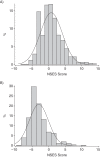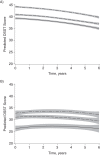Neighborhood Socioeconomic Status and Cognitive Function in Late Life
- PMID: 27257114
- PMCID: PMC4908209
- DOI: 10.1093/aje/kwv337
Neighborhood Socioeconomic Status and Cognitive Function in Late Life
Abstract
Neighborhood socioeconomic status (NSES) is associated with cognitive function, independently of individual demographic, health, and socioeconomic characteristics. However, research has been largely cross-sectional, and mechanisms of the association are unknown. In 1992-1993, Cardiovascular Health Study participants (n = 3,595; mean age = 74.8 years; 15.7% black) underwent cognitive testing and magnetic resonance imaging of white matter hyperintensities (WMH), and their addresses were geocoded. NSES was calculated using 1990 US Census data (block groups; 6 measures of wealth, education, and occupation). The Modified Mini-Mental State Examination (3MS) was used to assess general cognition, and the Digit Symbol Substitution Test (DSST) was used to assess speed of processing annually for 6 years. Associations of race-specific NSES tertiles with 3MS, DSST, and WMH were estimated using linear mixed-effects models accounting for geographic clustering, stratified by race, and adjusted for demographic, health, and individual socioeconomic status (education, income, lifetime occupational status) variables. In fully adjusted models, higher NSES was associated with higher 3MS scores in blacks (mean difference between highest and lowest NSES = 2.4 points; P = 0.004) and whites (mean difference = 0.7 points; P = 0.02) at baseline but not with changes in 3MS over time. NSES was marginally associated with DSST and was not associated with WMH. Adjustment for WMH did not attenuate NSES-3MS associations. Associations of NSES with cognition in late adulthood differ by race, are not explained by WMH, and are evident only at baseline.
Keywords: aging; cognitive function; health disparities; neighborhood socioeconomic status; white matter hyperintensities.
© The Author 2016. Published by Oxford University Press on behalf of the Johns Hopkins Bloomberg School of Public Health. All rights reserved. For permissions, please e-mail: journals.permissions@oup.com.
Figures



Similar articles
-
Racial Differences in Gray Matter Integrity by Diffusion Tensor in Black and White Octogenarians.Curr Alzheimer Res. 2015;12(7):648-54. doi: 10.2174/1567205011666141107153634. Curr Alzheimer Res. 2015. PMID: 25387332 Free PMC article.
-
Histories of neighborhood socioeconomic status contribute to race differences in later-life cognition.Alzheimers Dement. 2024 May;20(5):3342-3351. doi: 10.1002/alz.13786. Epub 2024 Mar 29. Alzheimers Dement. 2024. PMID: 38552138 Free PMC article.
-
The Association of Neighborhood Socioeconomic Status with Executive Function and Processing Speed in Cognitively Normal Mexican American Elders from the Health and Aging Brains Study: Health Disparities Cohort.Dement Geriatr Cogn Disord. 2024;53(4):180-189. doi: 10.1159/000539035. Epub 2024 Apr 25. Dement Geriatr Cogn Disord. 2024. PMID: 38663362 Free PMC article.
-
Neighborhood socioeconomic status and coronary heart disease risk prediction in a nationally representative sample.Public Health. 2012 Oct;126(10):827-35. doi: 10.1016/j.puhe.2012.05.028. Epub 2012 Oct 22. Public Health. 2012. PMID: 23083844 Free PMC article.
-
Joint Associations of Race, Ethnicity, and Socioeconomic Status With Mortality in the Multiethnic Cohort Study.JAMA Netw Open. 2022 Apr 1;5(4):e226370. doi: 10.1001/jamanetworkopen.2022.6370. JAMA Netw Open. 2022. PMID: 35404461 Free PMC article.
Cited by
-
Exposure to neighborhood concentrated poverty is associated with faster decline in episodic memory among midlife women.Alzheimers Dement. 2025 Apr;21(4):e70139. doi: 10.1002/alz.70139. Alzheimers Dement. 2025. PMID: 40189810 Free PMC article.
-
Defining critical factors in multi-country studies of assisted reproductive technologies (ART): data from the US and UK health systems.J Assist Reprod Genet. 2020 Nov;37(11):2767-2775. doi: 10.1007/s10815-020-01951-y. Epub 2020 Sep 30. J Assist Reprod Genet. 2020. PMID: 32995971 Free PMC article.
-
Neighbourhood Socioeconomic Processes and Dynamics and Healthy Ageing: A Scoping Review.Int J Environ Res Public Health. 2022 May 31;19(11):6745. doi: 10.3390/ijerph19116745. Int J Environ Res Public Health. 2022. PMID: 35682327 Free PMC article.
-
Psychological Pathways Linking Neighborhood Socioeconomic Factors to Cognitive Health in Black and White Older Adults.J Gerontol B Psychol Sci Soc Sci. 2025 Jun 10;80(7):gbaf082. doi: 10.1093/geronb/gbaf082. J Gerontol B Psychol Sci Soc Sci. 2025. PMID: 40297890
-
Social Vulnerability and Biological Aging in New York City: An Electronic Health Records-Based Study.J Urban Health. 2025 Apr;102(2):240-249. doi: 10.1007/s11524-024-00948-7. Epub 2025 Jan 14. J Urban Health. 2025. PMID: 39809980 Free PMC article.
References
-
- Gill TM, Richardson ED, Tinetti ME. Evaluating the risk of dependence in activities of daily living among community-living older adults with mild to moderate cognitive impairment. J Gerontol A Biol Sci Med Sci. 1995;505:M235–M241. - PubMed
-
- Park HL, O'Connell JE, Thomson RG. A systematic review of cognitive decline in the general elderly population. Int J Geriatr Psychiatry. 2003;1812:1121–1134. - PubMed
MeSH terms
Grants and funding
- U01 HL080295/HL/NHLBI NIH HHS/United States
- HHSN268201200036C/HL/NHLBI NIH HHS/United States
- N01 HC085079/HL/NHLBI NIH HHS/United States
- R01 HL080295/HL/NHLBI NIH HHS/United States
- KL2 TR000146/TR/NCATS NIH HHS/United States
- R01 AG023629/AG/NIA NIH HHS/United States
- R56 AG023629/AG/NIA NIH HHS/United States
- N01 HC085080/HL/NHLBI NIH HHS/United States
- P30 AG024827/AG/NIA NIH HHS/United States
- P50 AG005146/AG/NIA NIH HHS/United States
- N01 HC085082/HL/NHLBI NIH HHS/United States
- HHSN268200800007C/HL/NHLBI NIH HHS/United States
- N01 HC085086/HL/NHLBI NIH HHS/United States
- N01 HC085083/HL/NHLBI NIH HHS/United States
- T32 AG000181/AG/NIA NIH HHS/United States
- N01 HC055222/HL/NHLBI NIH HHS/United States
- N01 HC085081/HL/NHLBI NIH HHS/United States
- P30 AG044281/AG/NIA NIH HHS/United States
LinkOut - more resources
Full Text Sources
Other Literature Sources
Medical

